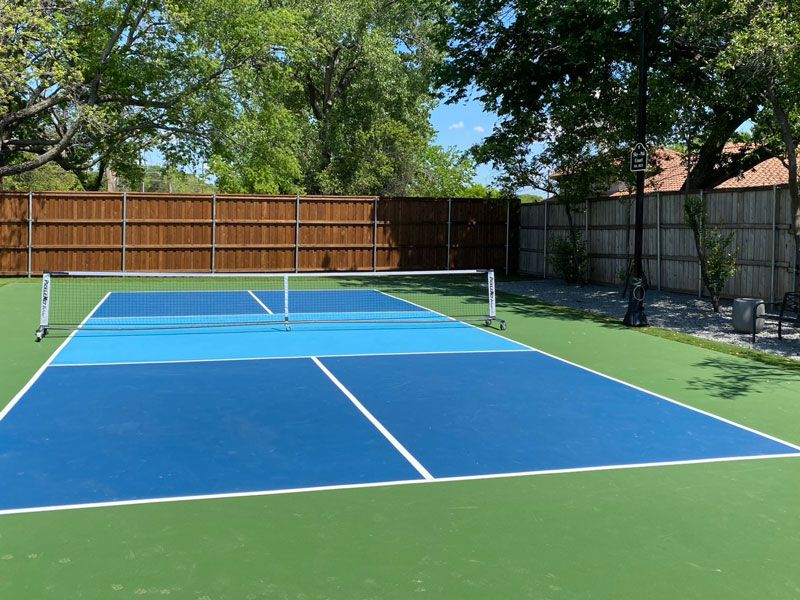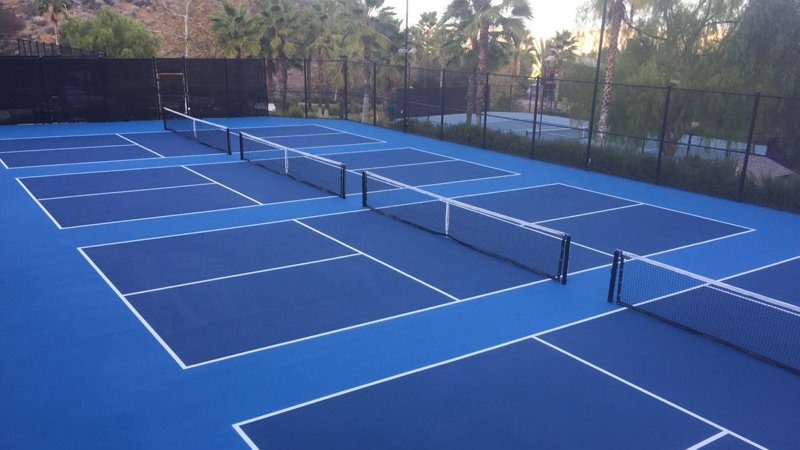Important Steps for Effective Pickleball Court Construction
Constructing a pickleball court requires mindful factor to consider of different elements to ensure an optimal playing setting. In addition, accurate adherence to court dimensions and internet specs is vital for fairness in play.
Determine Court Area

Orientation is an additional crucial element; courts ought to be positioned to decrease glare from the sunlight, preferably running north-south. This alignment assists players keep aesthetic clarity throughout play, particularly during morning or late mid-day sessions. In addition, the surrounding setting must be evaluated for possible diversions, such as noise from website traffic or close-by tasks, which may interfere with the pleasure of the game.
Access for all players, consisting of those with impairments, should additionally be prioritized in the option of the court place. Adequate pathways and seating locations ought to be incorporated into the style to accommodate everybody. In summary, a well-balanced court area not only boosts play conditions however also promotes an inviting atmosphere for gamers of all ability levels.
Select Appropriate Materials
Picking suitable products for the construction of a pickleball court is essential to making certain a high-grade playing surface and resilience - Pickleball court construction company. The option of products directly affects the efficiency of the court, gamer safety, and upkeep demands

In enhancement to the surface area, selecting proper net messages and webs is essential. Steel articles, powder-coated for weather resistance, guarantee security and longevity. The web itself needs to be of top quality nylon or polyester, created to hold up against wear and keep stress in time.

Understand Court Capacities
Exactly how can understanding the details dimensions of a pickleball court boost both gameplay and player experience? Knowledge with court dimensions is crucial for ideal play, ensuring that players can properly strategize and perform their shots. A conventional pickleball court measures 20 feet broad and 44 feet long for both songs and increases suits, with a non-volley zone, or kitchen area, expanding 7 feet from the net on either side. This layout affects shot choice, placing, and overall gameplay characteristics.
Correct adherence to court measurements permits fair play and adherence to official laws, cultivating a competitive atmosphere. Furthermore, recognizing these measurements aids in player safety by stopping congestion in assigned locations. The internet height is also an important facet, established at 36 inches at the sidelines and 34 inches at the facility, which influences the trajectory of returns and offers.
Moreover, exact dimensions promote the construction of courts that accommodate varying ability degrees, boosting the total gamer experience (Pickleball court construction company). By making certain that measurements are properly applied, gamers can take part in a well balanced and satisfying game, ultimately promoting the development of pickleball as a preferred sporting activity
Select Surface Type
Choosing the proper surface area type for a pickleball court is important for optimizing player efficiency and making sure security. The most common surface materials include asphalt, concrete, and specialized sporting activities surface areas, each offering distinct benefits and factors to consider.
Asphalt courts are popular due to their longevity and cost-effectiveness. They use great traction and are reasonably simple to maintain, making them ideal for neighborhood jobs. They may call for regular resurfacing to maintain optimum playing problems.
Concrete surfaces are another sensible choice, known for their strength and longevity. They give a constant playing experience and can be completed with various textures to boost grip. However, concrete can be hard on the joints, which might result in gamer fatigue over expanded play.
Specialized sports surface areas, such as acrylic or description modular ceramic tile systems, provide particularly to pickleball. These surface areas typically give exceptional shock absorption and grip, boosting player convenience and performance. They may entail higher first costs and maintenance factors to consider.
Inevitably, choosing the ideal surface area type needs mindful factor to consider of budget, expected use, and preferred having fun characteristics to create a safe and pleasurable pickleball atmosphere.
Prepare For Water Drainage and Lights
Efficient preparation for drainage and illumination is view it critical in the construction of a pickleball court, as it directly affects both playability and security. Correct water drainage systems ensure that water does not build up on the court surface, which can result in dangerous playing conditions and long-lasting damage to the surface. Carrying out a well-designed drainage plan involves evaluating the site's topography, soil kind, and neighborhood environment problems. It is vital to include sloping surfaces that route water away from the court and use proper water drainage materials, such as perforated pipelines and crushed rock, to facilitate efficient water overflow.
Along with drain, adequate lights is crucial for prolonging play and improving safety during evening suits. The illumination layout should provide consistent illumination throughout the court, lessening shadows and glow. This can be achieved via the installation of pole-mounted LED lights that are placed at suitable elevations and angles. It is crucial to consider neighborhood policies regarding light contamination and ensure that the illumination system does not negatively influence bordering buildings. By dealing with both water drainage and lighting successfully, the construction of a pickleball court can satisfy the needs of players while advertising a satisfying and secure environment.
Conclusion
Finally, successful pickleball court click for more construction requires mindful consideration of several factors, including location, materials, measurements, surface type, illumination, and drain. Each element plays a vital role in making sure a risk-free and satisfying having fun atmosphere. By sticking to these necessary actions, the building process can yield a high-grade court that satisfies the requirements of gamers while advertising the sport's growth and access. Appropriate planning and implementation will inevitably add to a sustainable and useful facility.
When preparing the construction of a pickleball court, selecting a proper court place is vital for ideal playability and availability. Appropriate drain systems guarantee that water does not build up on the court surface, which can lead to dangerous playing problems and lasting damage to the surface area - Pickleball court construction company. It is important to incorporate sloping surfaces that direct water away from the court and use proper drain products, such as perforated pipelines and gravel, to assist in efficient water drainage
By dealing with both water drainage and illumination effectively, the building and construction of a pickleball court can meet the requirements of players while promoting a risk-free and delightful atmosphere.
In conclusion, effective pickleball court construction requires careful factor to consider of multiple variables, consisting of location, materials, dimensions, surface area illumination, type, and water drainage.